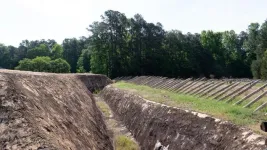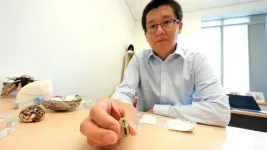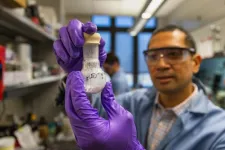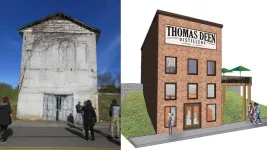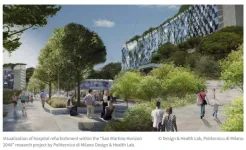(Press-News.org) The National Endowment for the Humanities awarded a $98,500 grant to an interdisciplinary team led by Virginia Tech to create an augmented reality program prototype that brings Civil War history to park visitors’ fingertips. Experts from Virginia Tech, Virginia Commonwealth University, Pamplin Historical Park, and its National Museum of the Civil War Soldier in Petersburg, Virginia, are involved in the project.
From multimedia-guided interpretations of documents to videos of historians sharing diverse perspectives, Pamplin Historical Park visitors will interact with historical lessons and stories of the site to inspire deeper empathy, curiosity, and understanding. Through augmented reality (AR), they’ll engage with stories of the people — both soldiers and noncombatants, such as the enslaved people of the area - their roles, their environment, the fight, the grit, and their beloved families.
“I’m passionate about visualizing the past, being able to see what is no longer to be seen, and gaining a perspective on how people once saw and experienced places that we see differently today,” said Todd Ogle, executive director of Applied Research in Immersive Experiences and Simulations. “I believe that using AR for this purpose is among its greatest potential uses.”
Previously, the team received a $30,000 grant to begin mapping out the project and analyzing what could be done. The new 2023-25 $98,500 grant is to continue the development and create an actual prototype of the augmented reality application. Next, the team plans to apply for another grant to move the project into full production.
The team is led by Paul Quigley, an associate professor in the Virginia Tech Department of History and director of the Virginia Center for Civil War Studies. Virginia Tech collaborators include Todd Ogle, executive director of Applied Research in Immersive Experiences and Simulations at the University Libraries; Doug Bowman, the Frank J. Maher Professor of Computer Science; Zach Duer, assistant professor in the School of Visual Arts; Corinne Guimont, digital scholarship coordinator in University Libraries; David Hicks, professor in the School of Education; Kurt Luther, associate professor in the Department of Computer Science and the Department of History; and Thomas Tucker, associate professor in the School of Visual Arts.
Other collaborators include Kathryn Shively, an associate professor of history at Virginia Commonwealth University, and staff of the Pamplin Historical Park and the National Museum of the Civil War Soldier.
The team will use digital recreations of historical landscapes, interactive 3D artifacts, short expert videos sharing compelling stories and key concepts, and digitally annotated historical documents and photographs.
“These techniques will convey historical lessons in bite-sized segments, grounded in compelling human stories, artifacts, or environmental features, using technologies that will draw different kinds of users in,” said Quigley.
The project marries new technologies with the latest historical scholarship on themes such as the environmental history of the Civil War, African American experiences of slavery and freedom, and how the crisis of the Civil War transformed gender relations and definitions of the household.
“We hope that augmented reality will unlock the stories of these lived experiences while connecting them to the landscape within which they occurred,” said Ogle.
This project allows Virginia Tech to demonstrate its commitment to its land-grant mission by supporting lifelong learning, helping the state’s economy through heritage tourism, and providing communities with new ways to understand their histories and their relevance today. “It is a truly transdisciplinary collaboration, bringing together the disciplinary tools of many different areas to create something that is more than the sum of its parts,” said Quigley.
One interesting challenge the team has faced is the difficulty of keeping up with changing technologies, with which different users have different levels of comfort. “If we do go all the way through to the production phase grant, we’ll probably finish the project around 2028,” said Quigley. “Along the way, we have to try to design an experience that will work with the devices that are in use in 2028 and beyond. Will that be smartphones, tablets, AR glasses, or something else? And we also have to make sure that everyone from school field trips to a history buff of retirement age will be able to get the most out of the experience.”
“Finding the right mix of accessibility, historical accuracy, and production value while working with the constantly changing technology landscape is an ongoing challenge,” said Ogle. “The opportunity is great enough to make the effort worthwhile.”
Quigley said there are immense benefits to understanding Civil War era history in all its dimensions, such as learning about how African Americans secured freedom and the impact the war had on individual lives, American politics and culture, and the natural environment. “It’s wonderful to be able to use engaging techniques to teach these subjects to audiences of different ages, different levels of interests, and different cultural backgrounds. There's something magical about developing a cool AR experience — a real ‘wow’ factor.”
END
Interdisciplinary team receives continued support to visualize the past
2023-06-09
ELSE PRESS RELEASES FROM THIS DATE:
Humanigen presents promising new hematologic data from PREACH-M trial for chronic myelomonocytic leukemia treatment at the 2023 European Hematology Association Congress
2023-06-09
- Of the 14 participants enrolled and treated with lenzilumab plus azacitidine, ten are evaluable with three to eighteen months of follow-up and all ten have had a rapid clinical response
- Building upon previously reported positive clinical responses, these additional data demonstrate statistically significant and clinically relevant improvements in hematologic outcomes, along with improvements in inflammatory markers, that occur in the early months after treatment initiation and appear durable
- CMML is a rare, aggressive cancer; approximately 20% of patients survive three years from diagnosis
- No ...
Megawatt electrical motor designed by MIT engineers could help electrify aviation
2023-06-09
CAMBRIDGE, Mass. -- Aviation’s huge carbon footprint could shrink significantly with electrification. To date, however, only small all-electric planes have gotten off the ground. Their electric motors generate hundreds of kilowatts of power. To electrify larger, heavier jets, such as commercial airliners, megawatt-scale motors are required. These would be propelled by hybrid or turbo-electric propulsion systems where an electrical machine is coupled with a gas turbine aero-engine.
To meet this need, a team ...
Ling Li leads team to see through eyes made of stone
2023-06-09
Ling Li, associate professor in the Department of Mechanical Engineering, has been awarded $1.05 million over three years to lead a team studying the visual abilities of a unique underwater creature with thousands of eyes.
The project reunites Li with a former collaborator, University of South Carolina Associate Professor Daniel Speiser. They also enlisted the expertise of an internationally recognized applied mathematician who specializes in image processing, Daniel Baum of the Zuse Institute in Berlin.
What stony eyes see and what it means
The team’s research will focus on the stony eyes of chitons. These marine creatures have pill-shaped, hard outer ...
Proof-of-Concept Program funds 12 research projects
2023-06-09
Virginia Tech Intellectual Properties (VTIP) with LINK + LICENSE + LAUNCH’s Proof-of-Concept Program has provided the springboard for faculty to bring their research to market. Over the past four years, the program has funded 24 Virginia Tech research projects.
“We are excited to be able to support a larger group of proof-of-concept projects in this award cycle,” said Mark Mondry who leads LAUNCH. “Several of the Virginia Tech faculty-led projects in this round include collaborations with students, industry partners, and other academic institutions, bringing diverse perspectives to the project ...
Community Design Assistance Center helps create opportunities in rural Virginia
2023-06-09
The rundown facade of the Thomas Deen building in St. Paul, Virginia, belied the once-impressive department store's better days.
The four-story brick building opened its doors to customers in the early 1920s, but over time, the structure was as forgotten as the discarded tires it housed some 100 years later. As Elizabeth Gilboy, the director of the Community Design Assistance Center, an outreach center in Virginia Tech's College of Architecture, Arts, and Design, and the center's team explored the site in fall 2020, they recognized their unique place at the intersection of the building's history and future.
Since ...
WHO recommends Politecnico di Milano guidelines for the design of future hospitals
2023-06-09
Milan, 9 June 2023 - The World Health Organisation presented in Baku (Azerbaijan) the new design recommendations for new hospitals to be built in the European Region, the result of a research partnership with the Politecnico di Milano. The document was prepared by the Design & Health Lab in the Department of Architecture, Construction Engineering and the Built Environment at the Politecnico under the coordination of Professor Stefano Capolongo.
The COVID-19 pandemic highlighted the importance of preparedness for natural and man-made disasters, emergencies and other social crises. The ability to provide continuous ...
3D 'bio-printing' inside hydrogels
2023-06-09
Scientists from the NIHR Great Ormond Street Hospital Biomedical Research Centre (a collaboration between GOSH and UCL), London, and University of Padova, Italy, have shown for the first time how 3D printing can be achieved inside ‘mini-organs’ growing in hydrogels -- controlling their shape, activity, and even forcing tissue to grow into 'moulds.'
This can help teams study cells and organs more accurately, create realistic models of organs and disease, and even better understand how cancer spreads through different tissues.
A particularly promising area of research at the Zayed Centre for Research ...
Scientists make a surprising discovery about magnetic defects in topological insulators
2023-06-09
Scientists from the Department of Energy’s Ames National Laboratory made an intriguing discovery while conducting experiments to characterize magnetism in a material known as a dilute magnetic topological insulator where magnetic defects are introduced. Despite this material’s ferromagnetism, the team discovered strong antiferromagnetic interactions between some pairs of magnetic defects that play a key role in several families of magnetic topological insulators.
Topological insulators (TIs) as their name indicates, ...
Novel ferroelectrics for more efficient microelectronics
2023-06-09
When we communicate with others over wireless networks, information is sent to data centers where it is collected, stored, processed, and distributed. As computational energy usage continues to grow, it is on pace to potentially become the leading source of energy consumption in this century. Memory and logic are physically separated in most modern computers, and therefore the interaction between these two components is very energy intensive in accessing, manipulating, and re-storing data. A team of researchers from Carnegie Mellon University and Penn State University is exploring materials that could possibly lead to the ...
Quantum materials: Electron spin measured for the first time
2023-06-09
An international research team has succeeded for the first time in measuring the electron spin in matter - i.e., the curvature of space in which electrons live and move - within "kagome materials", a new class of quantum materials.
The results obtained - published in Nature Physics - could revolutionise the way quantum materials are studied in the future, opening the door to new developments in quantum technologies, with possible applications in a variety of technological fields, from renewable energy to biomedicine, from electronics to quantum computers.
Success was ...
